Pizza is one of the most favourite foods in Canada and the United States or the worldwide, people loved for its convinence, and taste. However leftover pizza can become a food safety risk if not stored or reheated properly.
Understanding safe pizza storage handling and reheating is crucial to kill foodborne illness and enjoy your favorite pizza safely.
How Pizza Can Cause Food Poisoning?

improperly handled pizza can grow harmful bacteria like Salmonella Listeria E. coli or Staphylococcus aureus. According to the Canadian Food Inspection Agency (CFIA) and the U.S. Department of Agriculture (USDA) perishable foods like pizza should never be left at unsafe temperatures for long time.
Common symptoms in food poisoning:
- Diarrhea
- Nausea
- Fever
- Vomiting
- Weakness or fatigue
- Stomach cramp
People with weaker immune systems—children elderly individuals, and pragnent women are more vulnerable.
Why Pizza is a Food Poisoning Risk?
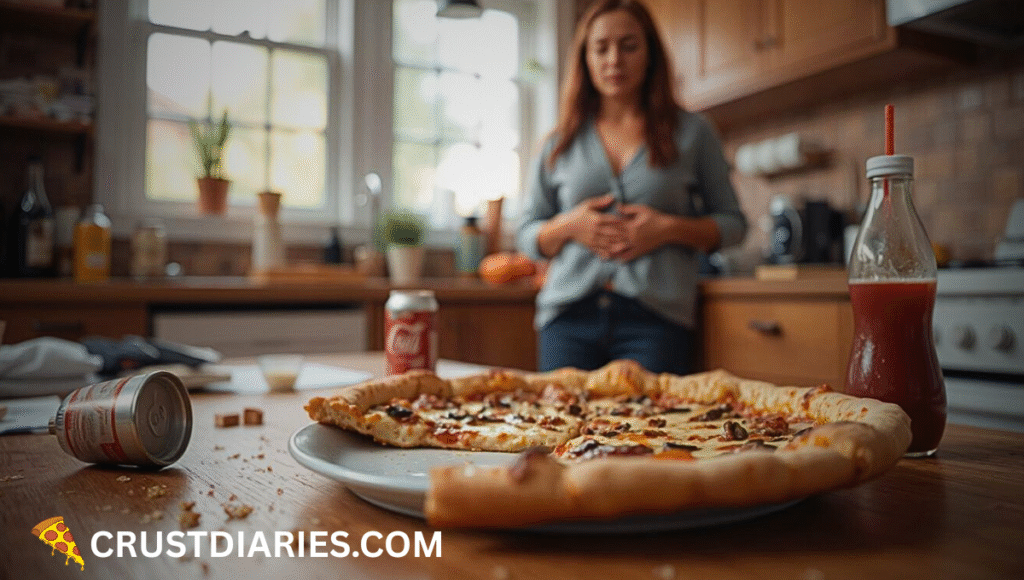
Pizza can carry multiple perishable ingredients that spoil quickly if mishandled:
- Meat (pepperoni, sausage, ground beef) → unsafe if left out too long.
- Cooked vegetables & tomato sauce → retain moisture that supports bacterial growth.
- Cheese → a mix of fat and moisture, creating a breeding ground for bacteria.
If pizza is not stored or reheated following Canadian or U.S. food safety guidelines it can cause foodborne illness in anyone consuming it.
Frozen Pizza Food Poisoning:
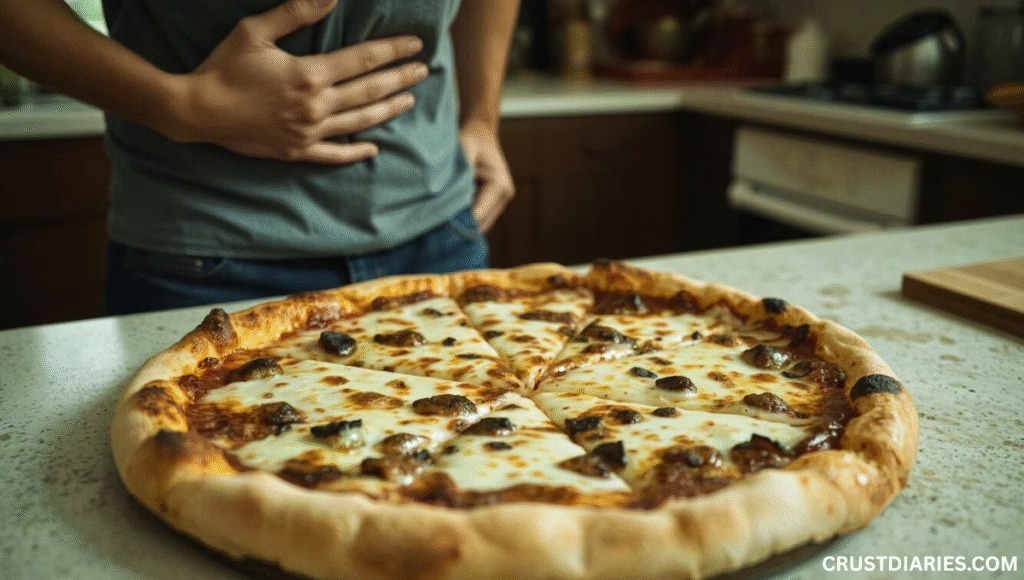
Many people don’t realize that frozen pizza food poisoning can occur if the slice of pizza is not cooked properly or stored at the wrong temperature. Different and Harmful bacteria like Salmonella or Listeria can survive in undercooked frozen foods, And leading to stomach pain, nausea, or diarrhea. To avoid food poisoning, You always follow the instructions on the packaging and make sure the pizza reaches the recommended internal temperature before eating
Costco Pizza Food Poisoning:

There have been many reports of Costco pizza food poisoning, Most of the customers eat slices from the food court. While Costco is known for maintaining quality, improper handling, cross-contamination, or not store food at the right temperature can sometimes cause foodborne illness. Before eating pizza always Wash your hands and ensure the pizza is fresh
Domino’s Pizza Food Poisoning:
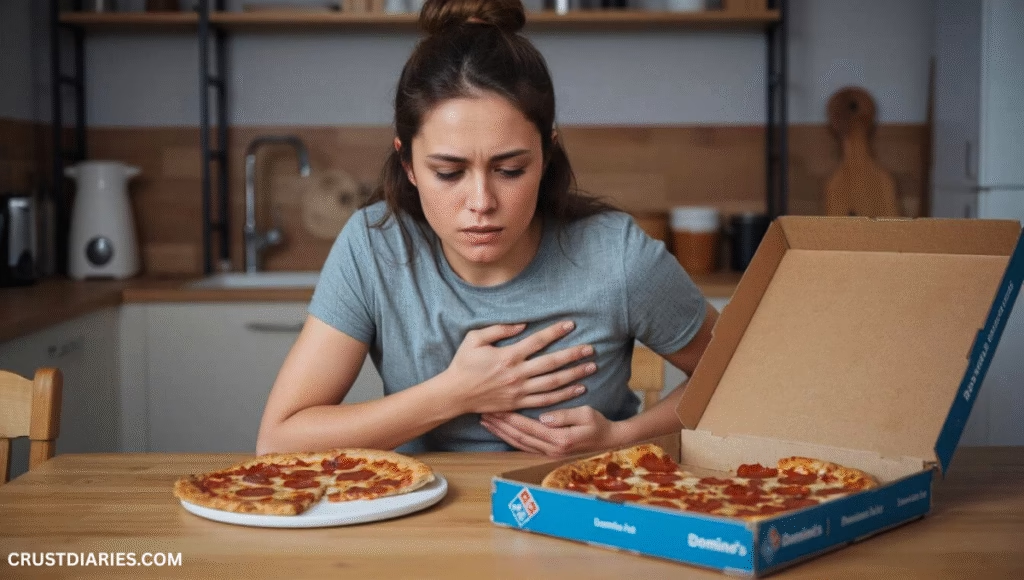
Cases of Domino’s pizza food poisoning have also been reported, especially around 25 August, where customers complained of stomach related issues after eating delivery pizza. Since Domino’s pizzas are usually fresh, the problem is often linked to either delivery delays, poor hygiene during preparation, or leaving the pizza at room temperature for too long. Reheating leftovers properly can help lower the chances of illness.
Red Baron Pizza Food Poisoning:

Even frozen brands are not immune to problems Red Baron pizza food poisoning, Cases have been mentioned online as well. This usually happens when the pizza is undercooked, stored in a warm place for too long, or consumed past its expiry date. Since frozen pizzas can carry bacteria if not handled properly, following storage guidelines and cooking instructions carefully is the best way to stay safe.
How Long Can You Keep Leftover Pizza?
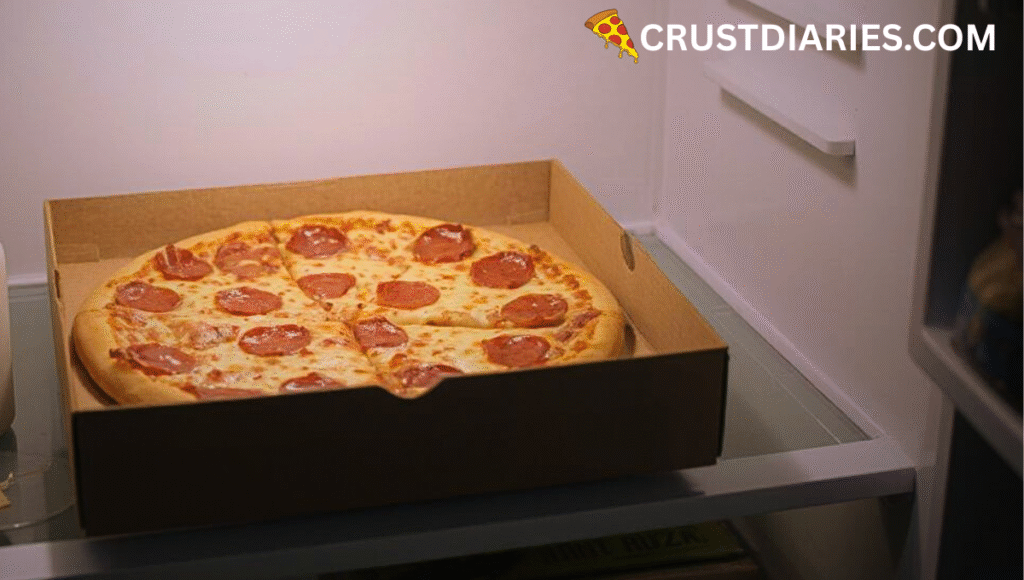
Store In the Fridge:
- Store leftover pizza within 2 hours after cooking or delivery.
- Maintain fridge temperature at or below 40°F (4°C).
- Eat within 3–4 days for safety.
At Room Temperature:
- Never eat pizza left out for more than 2 hours.
- In hot weather (90°F/32°C), refrigerate within 1 hour.
Between 40°F and 140°F, known as the danger zone, Bacteria multiply rapidly-especially Staphylococcus aureus, which thrives in improperly stored prepared food.
Common Mistakes in Pizza Storage That Lead to Food Poisoning
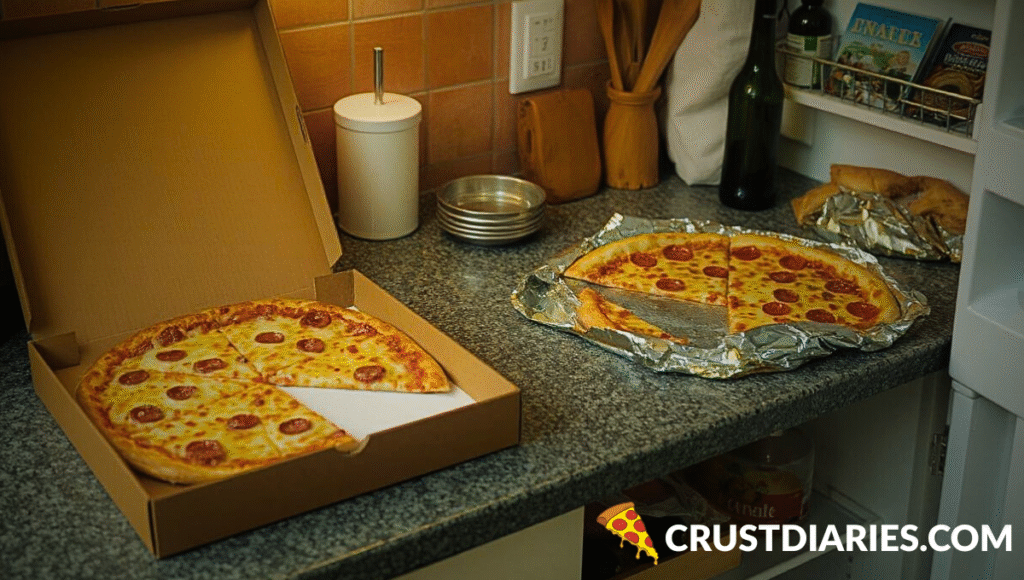
- Leaving pizza out overnight without refrigerate
- Using open containers instead of airtight storage.
- Skipping proper reheating or not checking temperature.
- Consuming leftovers after more than 4 days.
How to Tell If Pizza Has Gone Bad

clear signs of spoilage:
| Sign | What It Means |
|---|---|
| Sour or smell | Bacterial growth has begun |
| Slimy or sticky texture | Cheese or topping has spolied |
| color change | Mold or breakdown of ingredients |
| Off taste | Indicates spoilage—do not swallow |
| Mold spots on crust | Always discard entire slice/pizza |
Note: If in doubt, it’s safest to throw it out.
Best Practices to Store and Reheat Leftover Pizza Safely
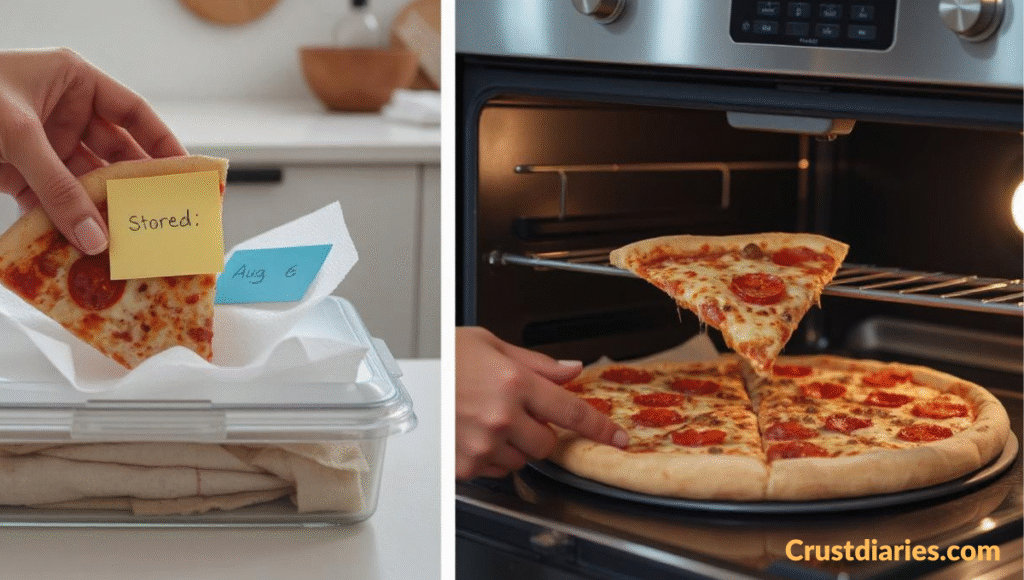
1. Wash Your Hands
- Reduce bacterial contamination before eating.
2. Refrigerate Properly
- Within 2 hours of cooking or delivery.
3. Use an Airtight Containers
- Maintain freshness and safety.
4. Label and Track Dates
- Write the date on containers If pizza is older than 4 days throw it away.
5. Freeze If Needed
- Up to 2 months for long-term storage.
6.Reheat Safely
- Heat to 165°F (74°C) using a food thermometer to kill bacteria.
What to Do if You Suspect Food Poisoning
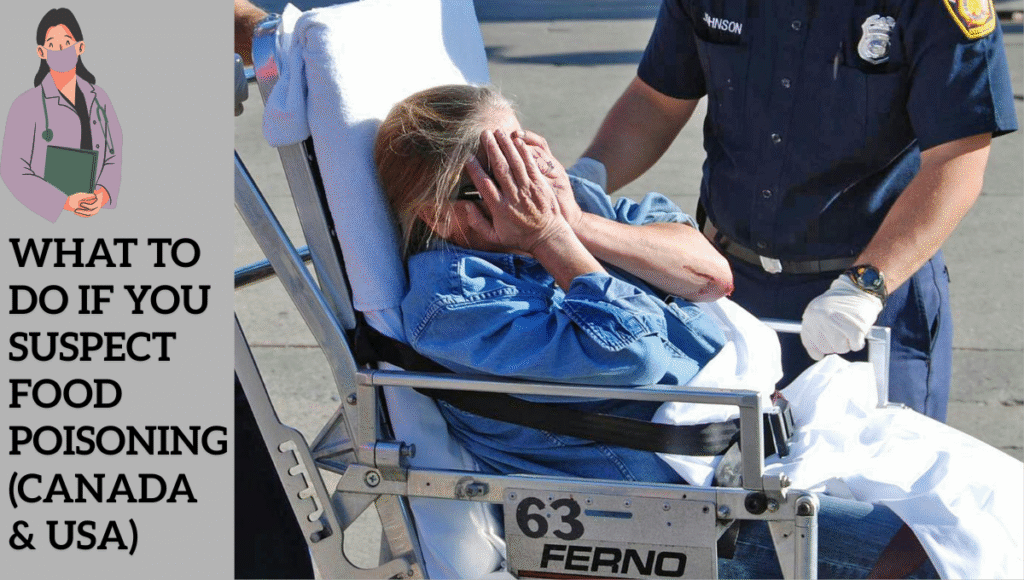
If you experience symptoms of food poisoning after eating pizza:
1-Stay hydrated:
- If you feel that you are having food poisoning first consult your doctor and as a precaution you can consume as much water broth or electrolyte solution as possible it may help you to stay hydrated..
2-Rest:
- After poisoning you need as much rest as possible because rest will help your body recover quickly.
3-Avoid anti-diarrheal medications:
- Avoid taking various types of medications without consulting a doctor
4-See a doctor:
- Seek medical help in Canada or the USA if symptoms include:
- High fever
- Blood in stool
- Persistent vomiting
- Dehydration signs
Report serious cases to local health authorities in Canada or the CDC in the U.S.
Final Thoughts: Enjoy Pizza Safely
Pizza is a delicious and convenient food, but safe handling, storage, and reheating are essential to prevent foodborne illness.
Pizza Safety Checklist
Store your pizza in the fridge for a maximum of 2 hours to preserve it store in airtight jars:
- For the best flavour make every effort to finish it in three or four days.
- Never eat pizza that has been sitting out overnight.
- Also avoid pizza that has a bad taste appearance or odor.
- Always store pizza in airtight containers or jars.
FAQs: Safe Leftover Pizza – Food Poisoning Prevention (USA & Canada)
Q1. How long is leftover pizza safe to eat in the fridge?
A1. Leftover pizza can be safely stored in the refrigerator for up to 3 – 4 days. After that, bacteria growth increases and the risk of food poisoning is higher.
Q2. Can I eat pizza that was left out overnight?
A2. No. Pizza left at room temperature for more than 2 hours is unsafe to eat because bacteria multiply quickly.
Q3. What are the signs that leftover pizza has gone bad?
A3. If the pizza smells sour, tastes strange, or shows signs of mold, it should not be eaten.
Q4. Can reheating pizza kill all bacteria?
A4. Reheating can kill some bacteria, but toxins already produced by bacteria will not be destroyed. That’s why very old pizza is unsafe even if reheated.
Q5. How should leftover pizza be stored safely?
A5. Always store pizza in an airtight container or wrap it tightly in foil/plastic wrap before refrigerating.
Q6. Can leftover pizza be frozen for longer storage?
A6. Yes, leftover pizza can be frozen for 1–2 months. Make sure to wrap it properly and reheat it thoroughly before eating.
Q7. What food poisoning symptoms can leftover pizza cause?
A7. Eating spoiled pizza may lead to nausea, vomiting, stomach cramps, and diarrhea. Seek medical attention if symptoms are severe.


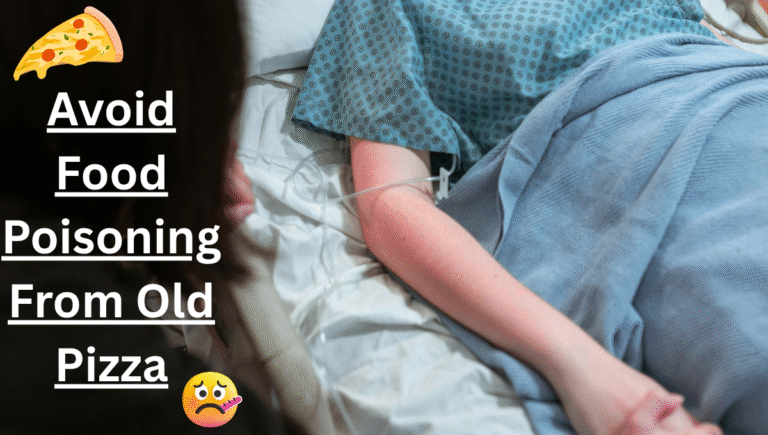


Pingback: 🧊🍕How long can pizza last in the fridge? - crustdiaries pi
Pingback: Pizza with a Twist: 6 Creative & Delicious Pizza Ideas You Must Try
Pingback: Pizza Storage Mistakes That Can Make You Sick – And How to Avoid Them - Crustdiaries
Pingback: Peri Peri Pizza | Homemade & Nando’s Style Spicy Pizza
Pingback: How Long Does Defrosted Chicken Last In The Fridge?
Pingback: What the Best Oil to Fry Chicken In? [Top 5 Oils + Pro Tips]